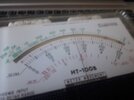tonigau
Member
This is probably more of a physics topic ?
I received a gift of a nice old forklift battery charger, It got wet outside in the rain.
I observed the ammeter needle move when I touched the front , played around a bit & got inconsistent but repeatable needle movement & it would even hold a position, (doesnt seem like sticky pivot) .
There would be high humidity inside the meter as there is h2o condensate visible inside the meter front.
___ Strange.
After dry out it no longer reacts to touch.
Video attached

I received a gift of a nice old forklift battery charger, It got wet outside in the rain.
I observed the ammeter needle move when I touched the front , played around a bit & got inconsistent but repeatable needle movement & it would even hold a position, (doesnt seem like sticky pivot) .
There would be high humidity inside the meter as there is h2o condensate visible inside the meter front.
___ Strange.
After dry out it no longer reacts to touch.
Video attached



